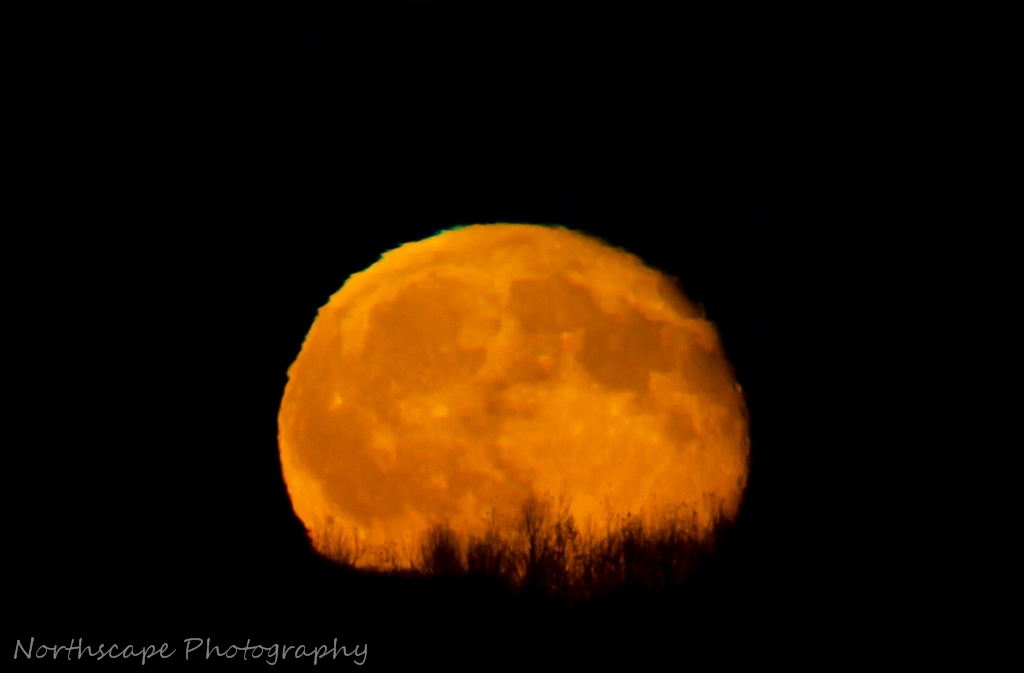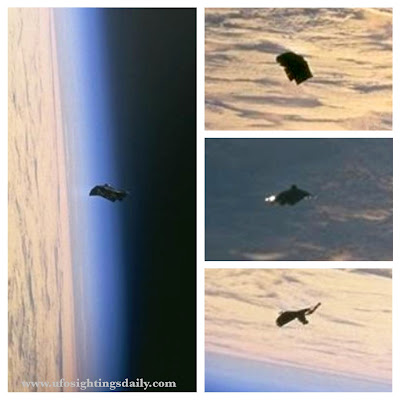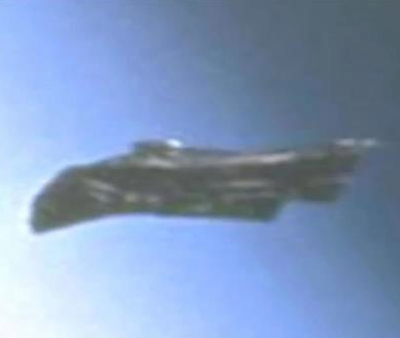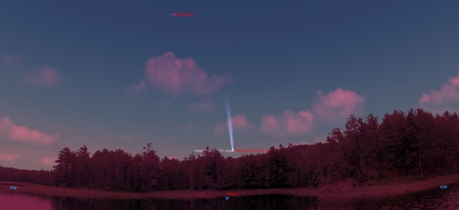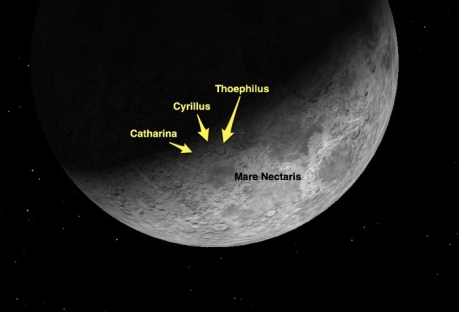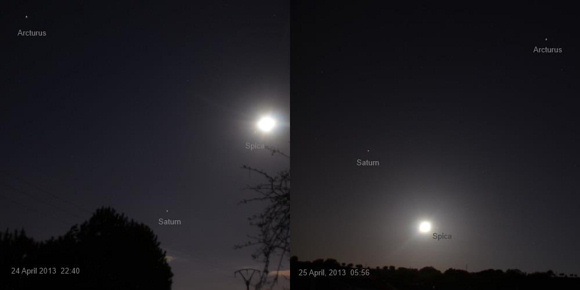Google+ Badge+page
Friday, April 26, 2013
Spring's First Full Moon Appears In Time for Easter
 The 2013 March full moon hangs bright over the Bodie Island Lighthouse in Outer Banks, N.C., in this photo from Greg Diesel Walck.
The 2013 March full moon hangs bright over the Bodie Island Lighthouse in Outer Banks, N.C., in this photo from Greg Diesel Walck.
The first full moon of the new spring season comes Wednesday night (March 27), and it plays a surprisingly important role for the upcoming Easter Sunday.
The moon officially turned full at 5:27 a.m. EDT (2:27 a.m. PDT), but your first view of the full moon at night will likely come later this evening. Traditionally, the March full moon is known as "Worm Moon," supposedly because when the ground softens, the earthworm casts reappear, inviting the return of the robins. But because of its association with Easter, it's also known as the Paschal Moon. Other lunar monikers for this month include "Crow Moon," (when the cawing of crows signals the end of winter), "Crust Moon," (because the snow cover becomes crusted from thawing by day and freezing at night) and "Sap Moon," (marking the time of tapping maple trees).Traditional names for the full moons of the year are found in some publications such as The Farmers' Almanac. We also published the full list of full moon names here on Space.com earlier this year. The origins of these names have been traced back to Native Americans, though they may also have evolved from old England or, as Guy Ottewell, editor of the annual publication "Astronomical Calendar" suggests, "writer's fancy." [10 Suprising Moon Facts You May Not Know]
The first full moon of spring is also sometimes referred to as the Paschal Full Moon, because it is the moon used to set the date of Easter in a given year. This year, if you have not already noticed, Easter will arrive a bit on the early side, on March 31. The earliest Easter in our lifetimes came five years ago, on March 23 (the last time that Easter fell this early in the calendar was 1913, and before that, in 1856).
Which leads us to ask the question, exactly just how is the date of Easter determined?
Equinox and the full moonTraditionally, Easter is observed on the Sunday after the Paschal Full Moon. If the Paschal Moon occurs on a Sunday, Easter is the following Sunday.
Following these rules, we find that Easter can fall as early as March 22 and as late as April 25 in any given year. Pope Gregory XIII decreed this in 1582 as part of the Gregorian calendar.
This year the Paschal Full Moon falls Wednesday, so according to the current ecclesiastical rules, Easter is to be celebrated four days later, on SundayInterestingly however, these rules also state that the vernal equinox is fixed on March 21, even though at European longitudes from the years 2008 through 2101 it actually will occur no later than March 20.
Hence, there can sometimes be discrepancies between the ecclesiastical and astronomical rules for dating Easter. In the year 2038, for instance, the equinox falls on March 20, with a full moon the next day, so astronomically speaking, Easter should fall on March 28 of that year. In reality, however, as mandated by the rules of the Church, Easter in 2038 will be observed as late as it can possibly come, on April 25!
Adding additional confusion is that there is also an "ecclesiastical" full moon, determined from ecclesiastical tables and whose date does not necessarily coincide with the "astronomical" full moon, which is based solely on astronomical calculations. In 1981, for example, the full moon occurred on Sunday, April 19, so Easter should have occurred on the following Sunday, April 26. But based on the ecclesiastical full moon, Easter occurred on the same day of the full moon, April 19.So in practice, the date of Easter is determined not from astronomical computations, but rather from other religious formulas such as Epachs and Golden Numbers. In 2013, we are in Epach 17 and the Golden Number is 19. [Who Observes Easter? (Infographic)]Since the beginning of the 20th century, a proposal to change Easter to a fixed holiday rather than a movable one has been widely circulated, and in 1963 the Second Vatican Council agreed, provided a consensus could be reached among Christian churches. The second Sunday in April has been suggested as the most likely date.
Changeable weather tooInterestingly, the fact that Easter occurs at a time of the year when weather patterns are transitioning from winter to spring, means a wide variation in the type of weather that can be expected, depending upon just when the holiday falls in a given year. Ask somebody what type of weather immediately comes to mind when Christmas is mentioned, and likely the answer will be cold and snowy. For the Fourth of July, it's probably sunny and hot.
Yet Easter can feature both of these extremes!
In 1970, Easter fell on March 29. In that year, a snowstorm hit the northeastern United States. In New York City, the famous Easter Parade had to be canceled, as four inches of snow fell, with as much as a foot of it in the northern suburbs.
And yet, just six years later, in 1976, Easter fell on April 18, which ended up going down in New York weather annals as the hottest Easter on record. Not only was the 96-degree Fahrenheit reading that day the hottest temperature recorded in Central Park that year, it was also the very first (and only time) that New York held the distinction of being the hottest location in the United States!
Editor's note: If you have an amazing picture of the full moon or any other night sky view that you'd like to share for a possible story or image gallery, send photos, comments and your name and location to Managing Editor Tariq Malik at spacephotos@space.com.
Google+. Original article on
UFO Sighting Photos leaked out of NASA-Johnson Space Center, 100% clear UFOs In High Detail.
Alert...NASA HAS DELETED ALL THE LINKS TO THESE UFO PHOTOS AS OF JAN 2013. :(
UFO Sighting Photos leaked out of NASA-Johnson Space Center, 100% clear UFOs In High Detail!
Take a look at these amazing photos that were leaked out of NASA Johnson Space Center. The quality of the photos is almost HD and the detail we see of the UFO recorded by a NASA satellite orbiting are incredible. The most important question here is not what they are...space stations or ships, but is the species that built them still on board those ships? It looks to me that these photos were taken by someone that works for NASA and had access the famous "airbrush room." That is where they erase all the UFOs or alien evidence out of photos before they are released to the public. These photos are real, I stake my reputation on it. SCW


At first when I watched the below video I thought it was not real. So I checked out each photo myself and I can confirm the video is 100% legit.


The UFOs it shows are in the NASA photos. It is a rare thing when a UFO photo sneaks its way out of NASA by accident, so this is a treasure for UFO researchers around the world.


I'll have to admit I was a little taken aback when I saw the original photos. How often do you get crisp 100% clear photos of a UFO and from non other that the US government to boot. With a source like that these photos cannot be disputed or debunked, but many have tried.


Don't take my word for it. Go to the photo links below and see them for yourself. Once you do, any doubt you once had about UFOs will vanish.


And to Zzentityzz who found an posted these on Youtube, great find!


UFO Sighting Photos leaked out of NASA-Johnson Space Center, 100% clear UFOs In High Detail!


At first when I watched the below video I thought it was not real. So I checked out each photo myself and I can confirm the video is 100% legit.


The UFOs it shows are in the NASA photos. It is a rare thing when a UFO photo sneaks its way out of NASA by accident, so this is a treasure for UFO researchers around the world.


I'll have to admit I was a little taken aback when I saw the original photos. How often do you get crisp 100% clear photos of a UFO and from non other that the US government to boot. With a source like that these photos cannot be disputed or debunked, but many have tried.


Don't take my word for it. Go to the photo links below and see them for yourself. Once you do, any doubt you once had about UFOs will vanish.


And to Zzentityzz who found an posted these on Youtube, great find!


Multiple UFO sightings over Sydney, Australia On March 23, 2013 In Infrared.
Date of sighting: March 23, 2013
Location of sighting: Sydney, Australia
Eyewitness states:
When I filmed the Moon large Object passed the Moon.Then soon another spheres object appeared above the Holsworthy, this large Spheres object was stationery then went slowly in to the cloud. This object wasn't visible. with out I R Infra red filter.When I placed the filter on my camera this object appeared again.
NASA Mars Rover Targets Unusual Rock Enroute to First Destination
 Curiosity Traverse Map Through Sol 43
Curiosity Traverse Map Through Sol 43
This map shows the route driven by NASA's Mars rover Curiosity through the 43rd Martian day, or sol, of the rover's mission on Mars (Sept. 19, 2012).
The route starts where the rover touched down, a site subsequently named Bradbury Landing. The line extending toward the right (eastward) from Bradbury Landing is the rover's path. Numbering of the dots along the line indicate the sol number of each drive. North is up. The scale bar is 200 meters (656 feet).
By Sol 43, Curiosity had driven at total of about 950 feet (290 meters). The Glenelg area farther east is the mission's first major science destination, selected as likely to offer a good target for Curiosity's first analysis of powder collected by drilling into a rock.
 On the Road to Glenelg
On the Road to Glenelg
Click on the image for larger version
This mosaic from the Mast Camera on NASA's Curiosity rover shows the view looking toward the "Glenelg" area, where three different terrain types come together. All three types are observed from orbit with the High-Resolution Imaging Science Experiment (HiRISE) camera on NASA's Mars Reconnaissance Orbiter. By driving there, Curiosity will be able to explore them.
One of the three terrain types is light-toned with well-developed layering, which likely records deposits of sedimentary materials. There are also black bands that run through the area and might constitute additional layers that alternate with the light-toned layers. The black bands are not easily seen from orbit and are on the order of about 3.3-feet (1-meter) thick. Both of these layer types are important science targets.
This mosaic is composed of seven images. The Mastcam 34-millimeter camera took a series of four images; embedded within that series is a second set of three images taken with the Mastcam 100-millimeter camera This mosaic from the Mast Camera on NASA's Curiosity rover shows a close-up view looking toward the "Glenelg" area, where three different terrain types come together. All three types are observed from orbit with the High-Resolution Imaging Science Experiment (HiRISE) camera on NASA's Mars Reconnaissance Orbiter. By driving there, Curiosity will be able to explore them.
This mosaic from the Mast Camera on NASA's Curiosity rover shows a close-up view looking toward the "Glenelg" area, where three different terrain types come together. All three types are observed from orbit with the High-Resolution Imaging Science Experiment (HiRISE) camera on NASA's Mars Reconnaissance Orbiter. By driving there, Curiosity will be able to explore them.
One of these terrain types is light-toned with well-developed layering, which likely records the deposition of sedimentary materials. There are also black bands that run through the area and might constitute additional layers that alternate with the light-toned layer(s). The black bands are not easily seen from orbit and are on the order of about 3.3-feet (1-meter) thick. Both of these layer types are important science targets.
This mosaic is composed of images taken with the Mastcam 100-millimeter camera.
 'Jake Matijevic' Contact Target for Curiosity
'Jake Matijevic' Contact Target for Curiosity
The drive by NASA's Mars rover Curiosity during the mission's 43rd Martian day, or sol, (Sept. 19, 2012) ended with this rock about 8 feet (2.5 meters) in front of the rover. The rock is about 10 inches (25 centimeters) tall and 16 inches (40 centimeters) wide. The rover team has assessed it as a suitable target for the first use of Curiosity's contact instruments on a rock. The image was taken by the left Navigation camera (Navcam) at the end of the drive.
The rock has been named "Jake Matijevic." This commemorates Jacob Matijevic (1947-2012), who was the surface operations systems chief engineer for the Mars Science Laboratory Project and the project's Curiosity rover. He was also a leading engineer for all of the previous NASA Mars rovers: Sojourner, Spirit and Opportunity.
 Phobos in Transit
Phobos in Transit
Mars has two small, asteroid-sized moons named Phobos and Deimos. From the point of view of the rover, located near the equator of Mars, these moons occasionally pass in front of, or "transit," the disk of the sun. These transit events are the Martian equivalent of partial solar eclipses on Earth because the outline of the moons does not completely cover the sun (in contrast, Earth's moon does block the entire sun during a total solar eclipse). These eclipses, like those on Earth, occur in predictable "seasons" a few times each Mars year.
As part of a multi-mission campaign, NASA's Curiosity rover is observing these transits, the first of which involved the moon Phobos grazing the sun's disk. The event was observed on Martian day, or sol, 37 (September 13, 2012) using Curiosity's Mast Camera, or Mastcam, equipped with special filters for directly observing the sun. In a series of high-resolution video frames acquired at about three frames per second for about two minutes, the outline of part of Phobos blocked about five percent of the sun.
This animation shows the transit as viewed by the Mastcam 100-millimiter camera (M-100) in nine frames. Another version of the animation is available (click on the image above), consisting of 20 frames taken by the Mastcam 34-millimeter camera (M-34), which has about one-third the resolution of the M-100. In total, 256 frames were taken by the M-100 and 384 frames for the M-34.
The transit was also observed by Curiosity's Rover Environmental Monitoring Stations (REMS) instrument, which saw about a five percent drop in the sun's ultraviolet radiation during the event.
Mission scientists use these events to very accurately determine the orbital parameters of the Martian moons. Phobos, for example, orbits very close to Mars and is slowly spiraling in to Mars because of tidal forces. These forces change the orbital position of Phobos over time, and accurate measurements of those changes can provide information about the internal structure of that moon and how it dissipates energy. Deimos orbits much farther away and is slowly spiraling out.
As part of a multi-mission campaign, NASA's Curiosity rover is observing Martian moon transits, the first of which involved the moon Phobos grazing the sun's disk. The event was observed on Martian day, or sol, 37 (September 13, 2012) using Curiosity's Mast Camera, or Mastcam, equipped with special filters for directly observing the sun. This image layout compares views from the Mastcam 34-millimeter lens (left) and the Mastcam 100-millimeter lens, which is designed to take zoomed-in shots with about three times higher resolution. These images were taken about 18 seconds apart.
Urban Observing March 2013
This month brings the possibility of the first bright comet of the year. Just past it’s closest approach the the Sun, PANNSTARs should be at its biggest and brightest early this month, but it’ll only be visible from the southern hemisphere. Look for some nice images from southern hemisphere photographers at the start of the month. By March 14 however, it moves far enough to be visible on the NW horizon an hour after sunset. Watch for it from mid March through mid April in the west and northwest after sunset. Although it should be fading by April, it will be circumpolar by that time, making it a good target for binoculars and small telescopes.

Comet PANSTARRS on March 25 at sunset. Note it will probably not be bright enough to see in the twilight without binoculars. (Image made using Starry Night)
Jupiter is farther west in the evening skies in March. It makes an excellent target for a small telescope in the evening. Use the Sky & Telescope Galilean Moons applet to identify the moons. If you have a slightly larger ‘scope and good skies, check out their applet for the visibility of the Great Red Spot.
While you’re looking at jupiter, be sure to check out the Orion nebula andPleiades cluster, high in the south an hour after sunset. They are both bright enough to be visible through fairly bad ligh pollution, though you won’t be able to see the nebulosity in the Pleiades.
Farther east, between Gemini and Leo, is M44 or the Beehive cluster. In darker skies this is a naked eye object. Binoculars reveal dozens of stars even in most cities.
Catch the double star Izar in bootes rising later in the evening.
Saturn rises late in the evening at the start of the month. Near the end of the month it should be up and easily visible by 11 pm.
Mercury starts the month in the glare of the Sun, but reappears in the morning skies near the end of the month. Look for it half an hour before dawn in the ENE during the last two weeks of the month.
Mars, and Venus are a bit too close to the Sun for easy observing this month.
The equinox falls on march 21 this year. Be careful of those due east-west streets if you’re driving around sunrise or sunset that day. It’s also a great day to figure out if your street really lines up with a cardinal point or not.
Moon is full on March 27.
On March 17, Look for the Hyades the moon and Jupiter All in a line together. I you have a telescope, look along the terminator near Mare Nectaris. There is a set of three craters there, Theophilus, Cyrillus, and Catharina. Just a bit farther south, look for the curving Rupes Altai escarpment.
April 25-26 partial lunar eclipse – how to observe – who will see it Post 1
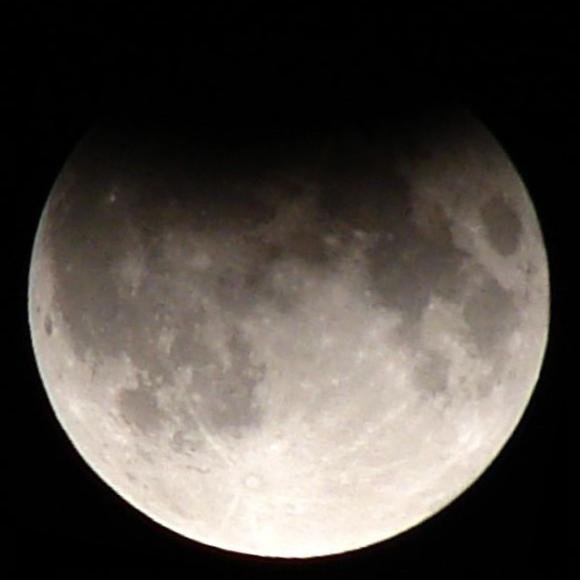

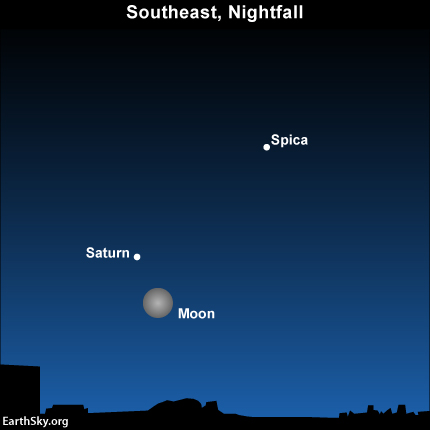
On the night of April 25, 2013 – the night of the partial lunar eclipse – the bright object near the moon is the planet Saturn.

On April 25-26, the full moon stays primarily within Earth’s faint penumbral shadow. Only the northernmost part of the moon dips into the dark umbral shadow, creating a brief partial eclipse. Image via Wikimedia Commons
What causes a partial eclipse? A lunar eclipse can only happen at full moon, when the moon lies generally opposite the sun in Earth’s sky. When Earth resides directly in between the moon and sun, then the Earth’s dark shadow totally falls upon the moon’s surface. On April 25-26, the alignment of sun-Earth-moon is a little off, so it’s only a partial eclipse.
A lunar eclipse happens when the long shadow of Earth touches the moons face. Earth’s shadow has two parts: a dark innerumbra and lighter surrounding penumbra. The moon does go into the darkest part of Earth’s shadow tonight, the umbral shadow, but only briefly. Thus tonight’s eclipse is an extremely shallow partial lunar eclipse, with only the northernmost portion of the moon passing through the Earth’s dark shadow for about 27 minutes. At the greatest eclipse, the Earth’s dark shadow will cover less than 1.5% of the moon’s diameter.
If you were on the part of the moon covered over by the Earth’s dark shadow, you’d see a total eclipse of the sun. Elsewhere on the side of the moon that faces Earth, you’d see a partial solar eclipse.
Worldwide map of 2013 April 25 partial eclipse of the moon
Who will see tonight’s eclipse? The worldwide map above shows where the lunar eclipse is visible from Earth. Where the gray swaths (South America, New Zealand) bracket the inner white area, there is only a hard-to-see faint penumbral eclipse. To view tonight’s partial umbral eclipse, you really have to live within the whiter portions on this map.
From the most of Europe and western Africa, the moon will be partially eclipsed shortly after sunset on April 25. Look low in your eastern sky. Binoculars may help you view the eclipse in the haze of dusk.
From the Middle East and western Asia, the partial eclipse happens at late night or around midnight April 25/26. The moon will be high in the sky in this part of the world.
From Australia, Indonesia or eastern Asia, the lunar eclipse takes place before sunrise on April 26. Look low in your western sky. Again, binoculars may help you to better see the eclipse in the haze of morning twilight.

Partial lunar eclipse of June 4, 2012 as captured by EarthSky Facebook friend Laurel Nendza. Thank you, Laurel!
What time should I watch for the eclipse? An eclipse happens at the same moment for the entire Earth, and thus our clocks say different times. We give the eclipse times below in Universal Time. Click here to find out how to convert Universal Time to the clock time in your time zone.
Penumbral Eclipse Begins: 18:03:38 UT
Partial Eclipse Begins: 19:54:08 UT
Greatest Eclipse: 20:07:30 UT
Partial Eclipse Ends: 20:21:02 UT
Penumbral Eclipse Ends: 22:11:26 UT
Partial Eclipse Begins: 19:54:08 UT
Greatest Eclipse: 20:07:30 UT
Partial Eclipse Ends: 20:21:02 UT
Penumbral Eclipse Ends: 22:11:26 UT
Day and night sides of Earth at greatest eclipse
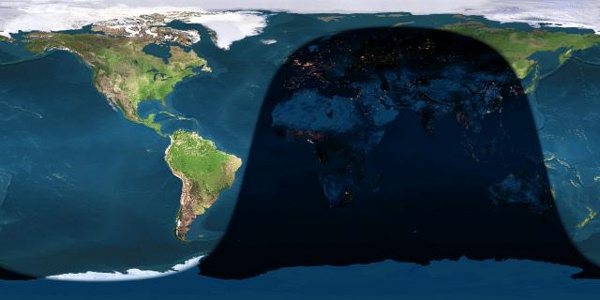
Day and night sides of Earth at greatest eclipse (2013 April 25 at 20:07:30 Universal Time). Image credit: Earth and Moon Viewer
Day and night on Earth at maximum eclipse. The map above shows you the day and night sides of Earth at the moment of greatest partial lunar eclipse (20:07:30 Universal Time on April 25). The shadow line to the right (running through Asia and to the left of New Zealand) represents sunrise. The shadow line to the left (running in between South America and Africa) represents sunset.
If the greatest eclipse happens at or near sunset (or sunrise) in your part of the world, look low in the opposite direction just after sunset (or before sunrise) for the eclipsed moon by the horizon. An unobstructed horizon and binoculars will undoubtedly enhance the view of the eclipse in the twilight glare.
Two more lunar eclipses are on tap for 2013 – on May 25 and October 18/19 – but both of them will be penumbral eclipses. During a penumbral lunar eclipse, the moon misses the Earth’s dark umbral shadow completely but passes through the faint penumbral shadow surrounding the dark umbra.
Bottom line: Parts of the world on April 25-26, 2013 (but not North or South America) will be able to watch a shallow partial eclipse of the full moon. This post contains eclipse info, including times, who will see it, and eclipse maps.
,
Subscribe to:
Posts (Atom)







